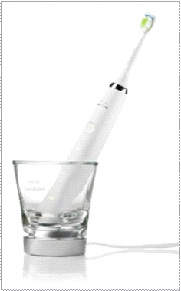
The American Dental Association recommends brushing your teeth twice a day for a full two minutes, thoroughly cleaning all surfaces of the teeth. It sounds easy, but it can be difficult to stick to that guideline, and inadequate or irregular brushing can lead to plaque buildup, tooth decay, and periodontal disease.
One of the best ways to make sure your teeth are getting the daily cleaning they need is to use an electric or sonic toothbrush. Both electric and sonic toothbrushes have a moving brush head designed to more effectively remove plaque, and many come with an automatic timer or auto-off switch to help you brush for the recommended two minutes.
Both electric and sonic tooth brushes can help you improve your brushing habits, and are easier to use than manual toothbrushes because they require less effort. Rather than performing the brushing action on your own, an electric or sonic toothbrush does the brushing for you—all you need to do is move the brush around your mouth, guiding it to reach all the surfaces of your teeth.
In addition to a single two-minute shut off, some electric and sonic toothbrushes include other beneficial features, including:
- 30-second alerts to tell you when to switch the brush to a new area of your mouth
- Pressure sensors to tell you if you are brushing with too much force
- Different modes for deep cleaning, whitening, tongue cleaning and sensitive teeth
- Reminders for when it’s time to replace the brush head
- Bluetooth connectivity that allows you to use an app on your smartphone to monitor your brushing and oral health
Both electric and sonic toothbrushes feature a vibrating or oscillating brush head that either spins in a circle or vibrates in a side-to-side motion. The main differences between the two are speed of brushing and coverage.
Electric toothbrushes have brush heads that rotate at a rate of about 2,500 to 7,500 strokes per minute, compared to about 300 strokes per minutes when you brush with a manual toothbrush. Sonic toothbrushes vibrate much faster, at about 30,000 brushes per minute. Because sonic toothbrushes vibrate at around 10 times the rate of an electric toothbrush, a two-minute brushing session with a sonic toothbrush will give you more cleaning power.
Another benefit of sonic toothbrushes is that they offer a secondary type of cleaning related to an effect called fluid dynamics. Because of the much higher rate of brush speed, sonic toothbrushes agitate the fluids in the mouth (water, saliva, and toothpaste), effectively turning them into cleaning agents that reach into crevices that the brush can’t access, like between teeth and below the gum line.
In a six-month study that compared the effectiveness of Sonicare sonic toothbrushes and Oral-B electric toothbrushes in improving oral health in adult periodontitis patients, users of both toothbrush types saw improvements in their overall oral health, but the sonic toothbrush proved significantly more successful at removing plaque, reducing gingivitis, and improving tooth and gum health.
While both electric and sonic toothbrushes offer excellent tooth cleaning, as dentists like to say, the best toothbrush is the one you will use. Choose a toothbrush that fits your specific needs and preferences to achieve optimal dental and oral health.
